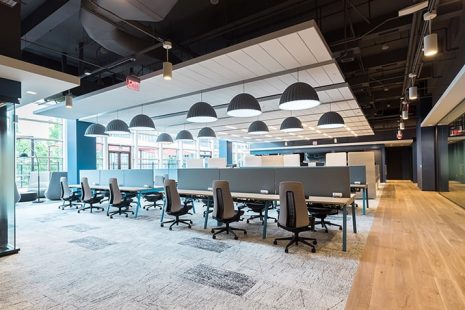Using PoE Lighting as the Foundation of a Smart Connected Building

Everyday life is becoming increasingly connected in both personal and professional arenas. IoT networks are continuing to expand, creating new opportunities to positively impact people, as well as for people to better impact their surroundings.
PoE lighting applications are driving adoption of IoT within office buildings due to their ability to also power and control additional connected sensors and systems.
Built on an ethernet-based infrastructure, when combined with a massive sensory network, PoE lighting can serve a whole range of applications within a smart building or smart office environment.
Controlling Natural Light
Integrating PoE lights with automatized shades provides full management of natural and artificial lighting. This increases comfort and productivity in offices, boardrooms, and other working spaces while conserving energy based on data derived from occupancy sensors within the lighting system.
Temperature and Humidity Control
Self-powered, wireless temperature and humidity sensors can leverage the connectivity already in place via connected lighting PoE nodes. This allows for more accurate temperature and humidity sensing capability in each space at a fraction of the cost of a traditional standalone HVAC solution. The collected data can then be passed to the building automation system or HVAC controls.
Safety and Security
Network-connected lighting can be integrated with a building’s fire alarm and other safety systems. In the event of a fire or other emergency that triggers a system alarm, building lights and multi-colored indicators can simultaneously react to illuminate pathways for occupants to follow while alerting them to an emergency situation. Network-connected lighting also can be integrated into a building’s digital signage and voice alarm platform, AV systems, window blinds, and security system.
Booking and Scheduling
Smart reservations let employees reserve meeting rooms. When occupancy data from lighting sensors indicates a “no-show”, the room can be “released” so other users can reserve the space. In addition, as soon as a space or room in use becomes available, an indicator LED can change status/color, so others will know that the space is open.
People Counting and Space Activities
As part of a sensory network, a PoE lighting system can act as host for advanced sensors that enable people counting, thereby gaining a better understanding of how and when space is utilized. This permits space management to be optimized, along with supporting building safety, by ensuring more people are not occupying a space than legally allowed.
Cleanliness and social distancing
As with other areas of our lives, the role and configuration of buildings and offices will change as a result of the pandemic. With the current shift in workspace environments, the ability to configure and reconfigure spaces digitally without making any physical changes will be in greater demand.
PoE lighting is ideally suited to support new smart, connected deployments that will likely be on the horizon. For example, PoE lighting sensors can be used in conjunction with smart office furniture to create a connected furniture/desk sensory network to ascertain whether specific desks are occupied. This will be important as businesses slowly migrate workers back to the office, most likely at half capacity or in shifts. Desks will be spaced farther apart and “hot desking” is likely to becoming more common.
Smart office furniture can be tied to smart desk apps that show which desks are available and allow users to “book” the desk for a certain time slot. When a desk becomes free, an alert can be sent to the cleaning team that it is ready for cleaning and disinfection. Once cleaned, the desk can be marked “available” on the app.
By supplying data about under- and over-utilization of office areas, companies can determine how to restructure existing physical spaces to prevent overcrowding and to optimize utilization. Social distancing could be supported through the use of lighting prompts.
Another approaching use case could be the integration of antibacterial or antiviral lights for automatic sterilization purposes. This could be accomplished by smart furniture or overhead lighting, which could be programmed to run overnight or after occupants leave a room or a desk.
Conclusion
Global revenues for smart commercial-building IoT is expected to increase to $84 billion by 2022, a 19.4 percent CAGR.7 IoT technologies will continue to deliver smarter, more automated and better-connected systems in new and existing buildings, especially as the demand for convenience and greater attention to the space and layout continue to rise. PoE-connected lighting is a key component of an IoT-driven smart building, bringing with it the ability to converge different functions within a single infrastructure to form the foundation of a highly integrated structure. As people continue adapting to the “new normal” in the physical workplace, PoE-connected lighting will grow as a foundation for IoT innovation that supports safer spaces.
Author: Giovanni Frezza
Full article
This is an excerpt of an article published in the October/November/December 2021 issue of ICT Today. Download the full article here
